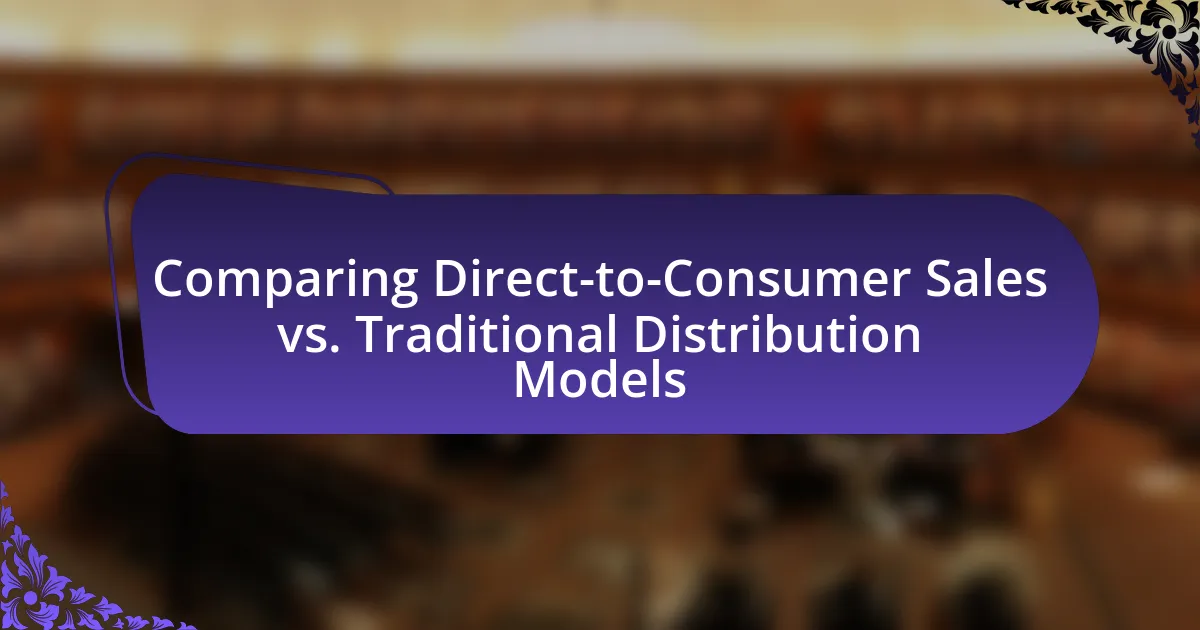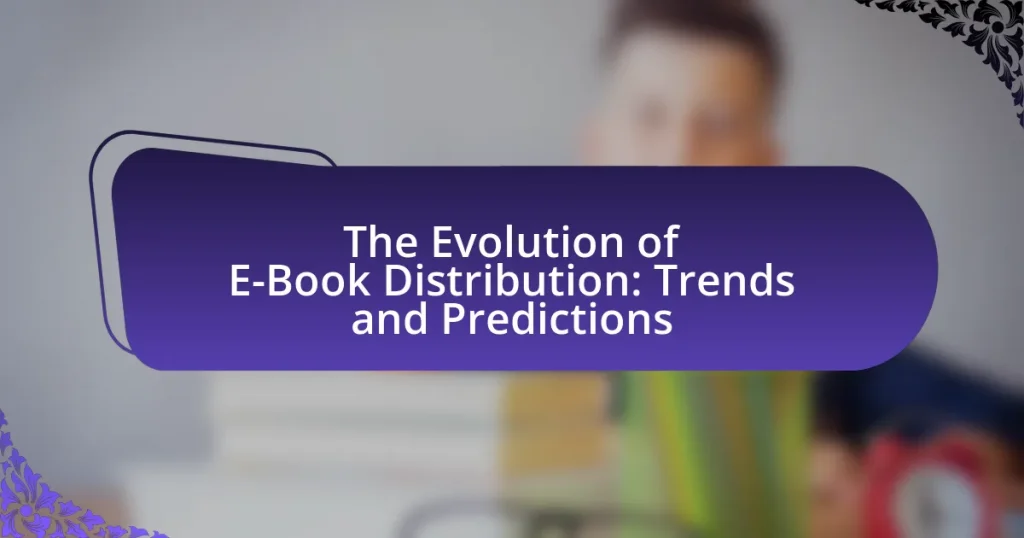The article focuses on comparing Direct-to-Consumer (DTC) sales and Traditional Distribution Models, highlighting their distinct characteristics and implications for businesses. DTC sales involve brands selling directly to consumers, allowing for greater control over pricing, branding, and customer relationships, while traditional models rely on intermediaries, which can dilute brand messaging and increase costs. Key advantages of DTC include enhanced customer engagement and higher profit margins, whereas traditional models offer established market reach and brand credibility. The article also addresses the challenges faced by both models, including customer acquisition costs and logistical complexities, providing insights for businesses to make informed decisions regarding their sales strategies.

What are Direct-to-Consumer Sales and Traditional Distribution Models?
Direct-to-Consumer (DTC) sales refer to a retail model where brands sell their products directly to consumers without intermediaries, allowing for greater control over pricing, branding, and customer relationships. In contrast, traditional distribution models involve multiple intermediaries, such as wholesalers and retailers, which can dilute brand messaging and increase costs. DTC sales have gained popularity due to the rise of e-commerce, with companies like Warby Parker and Dollar Shave Club exemplifying successful implementations, while traditional models have been the standard for decades, relying on established retail networks to reach consumers.
How do Direct-to-Consumer Sales differ from Traditional Distribution Models?
Direct-to-Consumer (DTC) sales differ from traditional distribution models primarily in their direct engagement with customers, eliminating intermediaries. In DTC, brands sell products directly to consumers through their own channels, such as websites or physical stores, allowing for greater control over pricing, branding, and customer experience. In contrast, traditional distribution models involve multiple intermediaries, such as wholesalers and retailers, which can dilute brand messaging and increase costs. For example, DTC brands like Warby Parker and Dollar Shave Club have successfully leveraged this model to enhance customer relationships and reduce prices by bypassing traditional retail markups.
What are the key characteristics of Direct-to-Consumer Sales?
Direct-to-Consumer (DTC) Sales are characterized by the direct interaction between brands and consumers, eliminating intermediaries. This model allows brands to control pricing, marketing, and customer experience, leading to increased brand loyalty and higher profit margins. DTC sales often leverage digital platforms for marketing and sales, enabling brands to gather consumer data for personalized marketing strategies. According to a report by McKinsey & Company, DTC brands have seen significant growth, with many achieving over 30% annual growth rates, highlighting the effectiveness of this sales approach in today’s market.
What are the defining features of Traditional Distribution Models?
Traditional distribution models are characterized by a multi-tiered approach involving intermediaries such as wholesalers and retailers. These models typically include features like a structured supply chain, where products move from manufacturers to distributors and then to retailers before reaching consumers. Additionally, traditional distribution relies on physical storefronts and face-to-face interactions, which can enhance customer service but may limit market reach compared to digital channels. Historical data shows that in 2019, approximately 80% of retail sales in the U.S. were still conducted through traditional channels, underscoring the model’s enduring relevance.
Why is it important to compare these two sales models?
Comparing direct-to-consumer sales and traditional distribution models is important because it allows businesses to evaluate the effectiveness, cost-efficiency, and customer engagement of each approach. Understanding these differences helps companies make informed decisions that can lead to increased profitability and better alignment with consumer preferences. For instance, direct-to-consumer sales often result in higher margins due to the elimination of intermediaries, while traditional distribution models may offer broader market reach. Analyzing sales data from both models can reveal insights into customer behavior and preferences, enabling businesses to tailor their strategies effectively.
What impact do these models have on consumer behavior?
Direct-to-consumer (DTC) sales models significantly influence consumer behavior by enhancing personalization and reducing costs. These models allow brands to gather direct feedback and data from consumers, enabling tailored marketing strategies that resonate more effectively with individual preferences. For instance, a study by McKinsey & Company found that DTC brands often achieve higher customer loyalty and engagement due to their ability to create personalized shopping experiences. Additionally, DTC models typically eliminate intermediaries, resulting in lower prices for consumers, which can lead to increased purchasing frequency and brand loyalty.
How do these models affect brand loyalty and customer relationships?
Direct-to-consumer (DTC) sales models significantly enhance brand loyalty and customer relationships by fostering direct engagement and personalized experiences. DTC allows brands to communicate directly with consumers, leading to a deeper understanding of customer preferences and needs. This direct interaction often results in higher customer satisfaction, as brands can tailor their offerings and marketing strategies based on real-time feedback.
Research indicates that brands utilizing DTC models see a 30% increase in customer retention rates compared to those relying on traditional distribution methods. This is largely due to the ability to create a more personalized shopping experience, which strengthens emotional connections between the brand and the consumer. Furthermore, DTC models often lead to increased customer lifetime value, as loyal customers are more likely to make repeat purchases and advocate for the brand, thereby enhancing overall customer relationships.

What are the advantages of Direct-to-Consumer Sales?
Direct-to-Consumer (DTC) sales offer several advantages, including increased profit margins, enhanced customer relationships, and greater control over branding. By eliminating intermediaries, companies can retain a larger share of revenue, as traditional distribution models often involve multiple layers of costs. Additionally, DTC sales facilitate direct engagement with customers, allowing businesses to gather valuable feedback and tailor their offerings to meet consumer needs more effectively. This direct interaction also fosters brand loyalty, as consumers feel a stronger connection to the brand. Furthermore, companies can maintain greater control over their marketing strategies and product presentation, ensuring a consistent brand message across all channels.
How does Direct-to-Consumer Sales enhance customer experience?
Direct-to-Consumer (DTC) sales enhance customer experience by providing personalized interactions and eliminating intermediaries. This model allows brands to engage directly with consumers, leading to tailored marketing strategies and product offerings that meet specific customer needs. For instance, DTC brands often utilize data analytics to understand consumer preferences, resulting in customized recommendations and improved satisfaction. Research indicates that 70% of consumers prefer personalized experiences, highlighting the effectiveness of DTC in fostering customer loyalty and enhancing overall experience.
What role does personalization play in Direct-to-Consumer Sales?
Personalization plays a crucial role in Direct-to-Consumer (DTC) sales by enhancing customer engagement and driving conversion rates. DTC brands leverage data analytics to tailor marketing messages, product recommendations, and shopping experiences to individual consumer preferences, which significantly increases the likelihood of purchase. For instance, a study by McKinsey & Company found that personalized experiences can lead to a 10-30% increase in sales, demonstrating the effectiveness of personalization in influencing consumer behavior. By creating a more relevant and customized shopping journey, DTC brands can foster stronger customer loyalty and differentiate themselves from traditional distribution models that often lack such tailored approaches.
How does pricing strategy differ in Direct-to-Consumer Sales?
Pricing strategy in Direct-to-Consumer (DTC) sales typically emphasizes lower prices due to the elimination of intermediaries. DTC brands can set prices that reflect direct costs and desired margins without the added markups that traditional retail channels impose. For instance, a study by McKinsey & Company found that DTC brands often achieve 30% higher margins compared to traditional retail due to reduced overhead and direct customer engagement. This allows DTC companies to offer competitive pricing while maintaining profitability, which is a significant departure from traditional distribution models that rely on multiple layers of pricing.
What challenges do businesses face with Direct-to-Consumer Sales?
Businesses face several challenges with Direct-to-Consumer (DTC) sales, including increased competition, customer acquisition costs, and logistical complexities. The rise of e-commerce has intensified competition, making it difficult for businesses to differentiate themselves and capture market share. According to a report by McKinsey, customer acquisition costs for DTC brands can be significantly higher than traditional models, often exceeding 30% of revenue. Additionally, managing logistics and fulfillment in-house can lead to operational inefficiencies and increased overhead, as businesses must handle inventory management, shipping, and returns without the support of established distribution networks. These factors collectively create a challenging environment for businesses transitioning to or operating within a DTC sales model.
How do logistics and fulfillment impact Direct-to-Consumer Sales?
Logistics and fulfillment significantly impact Direct-to-Consumer (DTC) sales by influencing delivery speed, customer satisfaction, and operational efficiency. Efficient logistics systems enable faster shipping times, which are crucial for meeting consumer expectations; for instance, 88% of consumers are willing to pay for faster delivery options. Fulfillment processes, including inventory management and order processing, directly affect the accuracy and reliability of order fulfillment, which can enhance customer trust and repeat purchases. According to a study by the National Retail Federation, 75% of consumers are more likely to shop with a retailer that offers same-day delivery, highlighting the importance of logistics in driving sales. Thus, effective logistics and fulfillment strategies are essential for maximizing DTC sales performance.
What are the marketing challenges associated with Direct-to-Consumer Sales?
The marketing challenges associated with Direct-to-Consumer (DTC) sales include customer acquisition costs, brand awareness, and logistics management. Customer acquisition costs can be significantly higher for DTC brands, as they must invest heavily in digital marketing strategies to attract consumers directly, often leading to a reliance on paid advertising. Brand awareness is another challenge, as new DTC brands must compete with established players in crowded markets, making it difficult to gain visibility and trust among consumers. Additionally, logistics management poses a challenge, as DTC brands are responsible for their own supply chain, which can lead to complexities in inventory management, shipping, and customer service. According to a report by McKinsey, DTC brands often face a 30% higher cost of customer acquisition compared to traditional retail models, highlighting the financial pressures associated with these marketing challenges.

What are the benefits of Traditional Distribution Models?
Traditional distribution models offer several benefits, including established market reach, reduced logistical burdens, and enhanced brand credibility. These models leverage existing relationships with wholesalers and retailers, allowing manufacturers to access a broader customer base without the need for extensive marketing efforts. Additionally, traditional distribution channels often have well-defined logistics and supply chain processes, which can lead to cost efficiencies in product delivery. Furthermore, products sold through recognized retailers can gain consumer trust, as these outlets often provide a sense of reliability and quality assurance.
How do Traditional Distribution Models provide market reach?
Traditional distribution models provide market reach by leveraging established networks of wholesalers, retailers, and distributors to deliver products to consumers efficiently. These models utilize intermediaries who have existing relationships and market knowledge, enabling brands to access a broader audience without the need for direct engagement with every individual customer. For instance, companies like Procter & Gamble rely on a vast network of retailers, which allows them to reach millions of consumers across various geographic locations. This extensive distribution network not only enhances visibility but also facilitates quicker market penetration, as products are placed in stores where consumers already shop, thus increasing the likelihood of purchase.
What types of retailers are involved in Traditional Distribution Models?
Traditional distribution models involve various types of retailers, including wholesalers, distributors, and brick-and-mortar stores. Wholesalers purchase goods in bulk from manufacturers and sell them to retailers, while distributors act as intermediaries that manage the logistics and supply chain between manufacturers and retailers. Brick-and-mortar stores, which include supermarkets, department stores, and specialty shops, serve as the final point of sale to consumers. These retailers collectively facilitate the movement of products from producers to end-users, ensuring that goods are available in physical locations for consumer purchase.
How do Traditional Distribution Models leverage established networks?
Traditional distribution models leverage established networks by utilizing existing relationships and infrastructure to efficiently deliver products to consumers. These models often rely on wholesalers, retailers, and distributors who have already built trust and recognition within specific markets, allowing for quicker market penetration and reduced costs associated with customer acquisition. For instance, companies like Procter & Gamble utilize a vast network of retailers to ensure their products are readily available to consumers, capitalizing on the retailers’ established customer bases and logistical capabilities. This approach not only enhances product visibility but also streamlines the supply chain, as these networks are already optimized for distribution, thereby improving overall efficiency and effectiveness in reaching target audiences.
What limitations exist within Traditional Distribution Models?
Traditional distribution models face several limitations, including inefficiencies in supply chain management, lack of direct customer engagement, and higher operational costs. These models often involve multiple intermediaries, which can lead to delays and increased costs due to markups at each stage. Additionally, traditional distribution does not facilitate direct communication between manufacturers and consumers, resulting in a disconnect that can hinder responsiveness to market demands. According to a study by McKinsey & Company, companies utilizing traditional distribution channels can experience up to 30% higher costs compared to direct-to-consumer approaches, highlighting the financial inefficiencies inherent in these models.
How does inventory management differ in Traditional Distribution Models?
Inventory management in Traditional Distribution Models typically relies on a centralized approach, where inventory is held at various distribution centers or warehouses before reaching retailers. This model often leads to higher carrying costs and longer lead times due to the multiple layers of distribution involved. For instance, according to a study by the Council of Supply Chain Management Professionals, traditional models can result in inventory turnover rates that are significantly lower than those seen in Direct-to-Consumer sales, where companies can manage inventory more efficiently by shipping directly to customers. This centralized inventory management in traditional models can also lead to stockouts or overstock situations, as demand forecasting is less responsive compared to the agile systems used in direct sales.
What are the implications of reduced control over branding in Traditional Distribution Models?
Reduced control over branding in Traditional Distribution Models leads to inconsistent brand messaging and diminished customer loyalty. When manufacturers rely on intermediaries, such as wholesalers and retailers, they often lose the ability to dictate how their brand is presented and perceived. This can result in variations in product display, marketing strategies, and customer interactions, which may confuse consumers and weaken brand identity. For instance, a study by the Harvard Business Review highlights that brands with strong direct-to-consumer strategies experience 30% higher customer retention rates compared to those relying on traditional distribution, underscoring the importance of cohesive branding in fostering loyalty.
How can businesses choose between Direct-to-Consumer Sales and Traditional Distribution Models?
Businesses can choose between Direct-to-Consumer (DTC) sales and Traditional Distribution Models by evaluating their target market, product type, and operational capabilities. DTC sales allow businesses to engage directly with consumers, often resulting in higher profit margins and better customer insights, while Traditional Distribution Models leverage established retail networks to reach a broader audience. For instance, companies like Warby Parker successfully utilize DTC to build brand loyalty and reduce costs, whereas brands like Procter & Gamble rely on traditional distribution to maximize market penetration. Analyzing factors such as customer demographics, product complexity, and distribution costs can guide businesses in making an informed decision.
What factors should be considered when selecting a sales model?
When selecting a sales model, key factors include target market characteristics, product type, cost structure, and sales channel effectiveness. Understanding the target market is crucial, as different demographics may respond better to direct-to-consumer approaches or traditional distribution. The product type also influences the choice; for instance, high-touch products may benefit from direct sales, while mass-market items might be better suited for traditional distribution. Cost structure considerations involve analyzing the expenses associated with each model, including marketing and logistics. Finally, evaluating the effectiveness of sales channels ensures that the chosen model aligns with the company’s overall strategy and goals.
How can businesses effectively transition between sales models if needed?
Businesses can effectively transition between sales models by conducting a thorough analysis of their current market position and customer needs, followed by strategic planning and implementation. This involves assessing the strengths and weaknesses of both the current and target sales models, identifying key performance indicators, and understanding customer preferences. For instance, a company may analyze sales data to determine the effectiveness of direct-to-consumer sales versus traditional distribution, revealing that a shift could enhance customer engagement and profitability. Additionally, successful transitions often require training staff on new processes and technologies, ensuring that the team is equipped to support the new model. Research indicates that companies that adapt their sales strategies in response to market changes can achieve a competitive advantage, as seen in the shift of many retailers to e-commerce during the COVID-19 pandemic, which resulted in significant revenue growth for those who embraced direct-to-consumer approaches.



